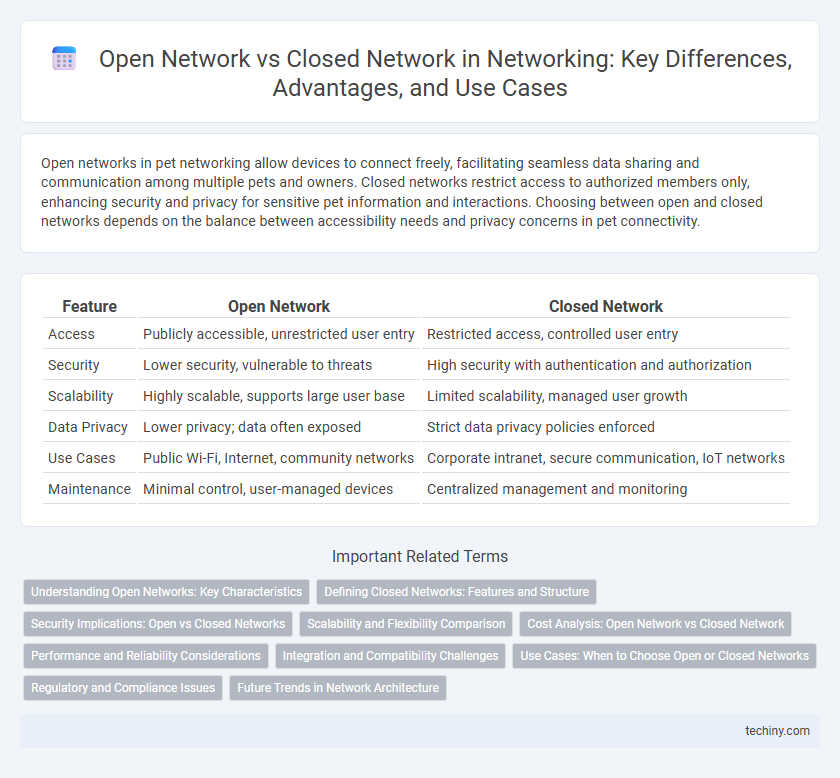Open networks in pet networking allow devices to connect freely, facilitating seamless data sharing and communication among multiple pets and owners. Closed networks restrict access to authorized members only, enhancing security and privacy for sensitive pet information and interactions. Choosing between open and closed networks depends on the balance between accessibility needs and privacy concerns in pet connectivity.
Table of Comparison
| Feature | Open Network | Closed Network |
|---|---|---|
| Access | Publicly accessible, unrestricted user entry | Restricted access, controlled user entry |
| Security | Lower security, vulnerable to threats | High security with authentication and authorization |
| Scalability | Highly scalable, supports large user base | Limited scalability, managed user growth |
| Data Privacy | Lower privacy; data often exposed | Strict data privacy policies enforced |
| Use Cases | Public Wi-Fi, Internet, community networks | Corporate intranet, secure communication, IoT networks |
| Maintenance | Minimal control, user-managed devices | Centralized management and monitoring |
Understanding Open Networks: Key Characteristics
Open networks allow unrestricted access to users and devices, promoting seamless connectivity and collaboration across diverse platforms. They rely on standard protocols like Wi-Fi and Ethernet, enabling easy integration and scalability without stringent access controls. Security challenges, such as increased vulnerability to unauthorized access and data interception, necessitate robust encryption methods and continuous monitoring.
Defining Closed Networks: Features and Structure
Closed networks are characterized by restricted access, allowing only pre-approved devices or users to connect. These networks prioritize security by employing strict authentication protocols and controlled data flow, minimizing exposure to external threats. The structure typically involves isolated segments, regulated gateways, and limited external communication to maintain a secure environment.
Security Implications: Open vs Closed Networks
Open networks expose data to a higher risk of unauthorized access and eavesdropping due to their lack of encryption and authentication protocols. Closed networks enforce strict access controls and robust encryption standards, significantly reducing vulnerabilities to cyberattacks and data breaches. Network administrators prioritize closed networks for sensitive environments to ensure data integrity and secure communications.
Scalability and Flexibility Comparison
Open networks offer superior scalability by allowing seamless integration of diverse devices and technologies without vendor lock-in, supporting rapid expansion and adaptation to changing requirements. Closed networks provide limited flexibility due to proprietary protocols and hardware restrictions, which hinder scalability and complicate the addition of new components. Scalability in open networks is enhanced by standardized interfaces and community-driven innovations, whereas closed networks often require costly upgrades or replacements to accommodate growth.
Cost Analysis: Open Network vs Closed Network
Open networks typically reduce operational costs by leveraging shared infrastructure and minimizing proprietary hardware expenses, making them more budget-friendly for large-scale deployments. Closed networks incur higher upfront investments due to exclusive hardware, software licensing fees, and dedicated management personnel, resulting in increased long-term maintenance costs. Evaluating total cost of ownership for open versus closed network solutions is critical for organizations balancing cost efficiency against security and control requirements.
Performance and Reliability Considerations
Open networks offer greater interoperability and scalability, which can enhance overall performance by allowing diverse devices to communicate seamlessly. However, closed networks often provide superior reliability and security through controlled environments that reduce vulnerabilities and minimize downtime. Performance in closed networks benefits from optimized configurations tailored to specific applications, while open networks may face variability due to heterogeneous devices and protocols.
Integration and Compatibility Challenges
Open networks promote seamless integration by supporting diverse hardware and software standards, enabling easier interoperability across multiple platforms. Closed networks face significant compatibility challenges due to proprietary protocols and restricted access, which limit the ability to incorporate third-party devices or services. These restrictions in closed networks often lead to increased costs and complexity in maintaining and expanding network infrastructure.
Use Cases: When to Choose Open or Closed Networks
Open networks are ideal for scenarios requiring broad accessibility and flexibility, such as public Wi-Fi in cafes, libraries, or community centers where user convenience and ease of connection are priorities. Closed networks suit environments demanding heightened security and controlled access, like corporate offices, financial institutions, and government agencies with sensitive data protection needs. Selecting between open and closed networks depends on factors including security requirements, user management, and the intended scale of connectivity.
Regulatory and Compliance Issues
Open networks often face increased regulatory scrutiny due to their exposure to broader user bases and potential vulnerabilities, requiring strict adherence to data protection laws such as GDPR and HIPAA. Closed networks benefit from controlled environments, simplifying compliance with industry-specific regulations by limiting access and monitoring internal traffic more effectively. Ensuring regulatory compliance in both network types involves implementing robust security protocols, regular audits, and comprehensive user access controls.
Future Trends in Network Architecture
Open networks promote interoperability and scalability by leveraging standardized protocols and decentralized management, enabling seamless integration of diverse devices and services. Closed networks emphasize security and control, often employing proprietary technologies to restrict access and maintain stringent governance. Emerging trends suggest a hybrid approach combining open network flexibility with closed network protections, driven by advancements in software-defined networking (SDN) and network function virtualization (NFV).
open network vs closed network Infographic

 techiny.com
techiny.com